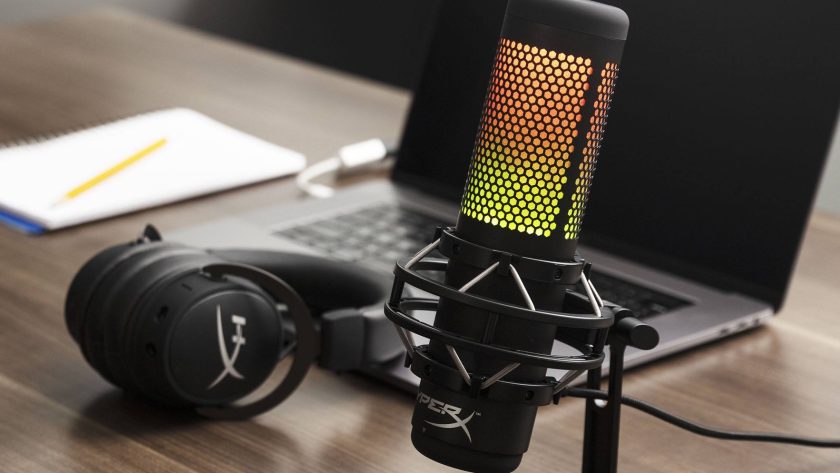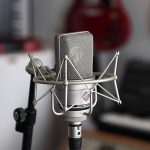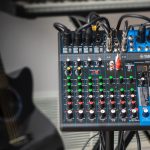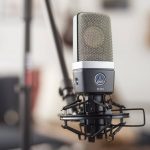In this review we feature the best podcast microphones that are very easy to setup with your PC or gaming console and are great for recording and streaming vocals. These microphones are designed specifically for podcasting and can capture your voice cleanly with the ability to customize the sound of your microphone.
When many beginners first start out, they go for something like the Shure SM58-LC dynamic microphone to record vocals. However, I don’t recommend using the SM58-LCs for podcasting because a podcasting microphone is more specialised towards capturing your voice with the right angle and making your voice sound more realistic and engaging for podcasts. Podcasting mics also come with built-in pop filters and shock mounts which reduce plosives in voice recordings, and are essential for clean podcasts and live streams.
How does a podcast microphone differ from a “normal” mic?
Generally speaking, a good podcasting microphone will have four characteristics:
- Cardioid pickup pattern to reduce noise: Podcasting microphones generally have cardioid polar patterns to reduce ambient sound pickups for a cleaner audio recording of your voice
- Sound customization: When recording podcasts, one of the features that you would want to have is the ability to customize the pickup of your voice as you will never know how your voice will sound in an actual podcast (depending on your room environment and recording conditions). Some podcast mics have the ability to reduce surrounding pickup which is especially useful if you are recording in a noisy environment, while some mics also offer switches to reduce low-frequency bass pickup which can reduce the “boomy” sound if you are too close to the mic.
- Pop filter to prevent plosives: When podcasting and recording vocals up-close, you would want to get a mic that comes with an internal pop filter that will filter out the plosive noises that can sound really irritating while podcasting – this helps to keep your recordings clean and precise
- Shock mount to prevent vibration pickup: A shock mount is a really useful feature to prevent low-frequency vibration pickup (such as typing on the keyboard during live streams or touching the table – it reduces the “bang” sound that you would hear during podcasts). It also protects against unwanted thumps and bumps from being picked up while recording vocals.
Here are some of the best podcast microphone for beginners that come with the above features and makes the recording process much smoother and easier. They are also USB compatible and are essentially plug and play straight out of the box.
1. HyperX Quadcast S Podcast Mic

One of the best podcasting microphones for beginners with plenty of built-in features…
The HyperX QuadCast S is a USB condenser microphone designed for podcasting and live streaming. It features radiant RGB lighting with dynamic effects, a built-in anti-vibration shock mount, a tap-to-mute sensor with LED status indicator and more importantly 4 selectable polar patterns (stereo, omnidirectional, cardioid, bidirectional) which allow you to adjust the sound pickup when required. The microphone also features customizable RGB lighting via the HyperX Ngenuity software, gain control adjustment, and multi-device and program compatibility. Its frequency response is 20Hz to 20kHz, and it has a sensitivity of -36dB, sampling at 48Hz with a 16-bit bitrate which provides really clean vocal picksup.
I really like the sound quality of the HyperX Quadcast S podcast mic – it also comes with a built-in anti-vibration shock mount, which helps suppress unintentional rumbles and bumps. The tap-to-mute sensor with LED status indicator provides convenient functionality, and the 4 selectable polar patterns provide versatility for different recording situations. With that said, the HyperX Quadcast S lacks some customizable filters in the HyperX Ngenuity app which would have added extra customization to the sound pickup.
Compared to other podcasting microphones, the HyperX QuadCast S has a simple and beginner-friendly design that is essentially plug and play. It has a customizable RGB lighting, built-in anti-vibration shock mount, and tap-to-mute sensor with LED status indicator. In contrast, the Blue Yeti Nano and the Rode NT-USB Mini offer higher sampling or bitrates, but may lack the customizable RGB lighting and built-in anti-vibration shock mount features of the QuadCast S. The Quadcast S is more suitable for beginners as it comes with basically everything you need to get started.
While the HyperX Quadcast S does not provide XLR connectivity like the Shure MV7 for professional-level sound quality, we found the USB input really easy to use and the mic still sounds really good for live streams. It may not capture subtle nuance like the Shure MV7 but it is still good at capturing a lot of details in the vocals and make them sound engaging and lifelike.
I recommend the HyperX QuadCast S for beginners in podcasting due to its user-friendly features, such as the tap-to-mute sensor, 4 selectable polar patterns, and the built-in anti-vibration shock mount, which help optimize the recording setup and prevent unintended audio disturbances. Additionally, its multi-device and program compatibility make it a versatile option for individuals starting their podcasting journey.
2. FIFINE K688 USB/XLR Dynamic Microphone
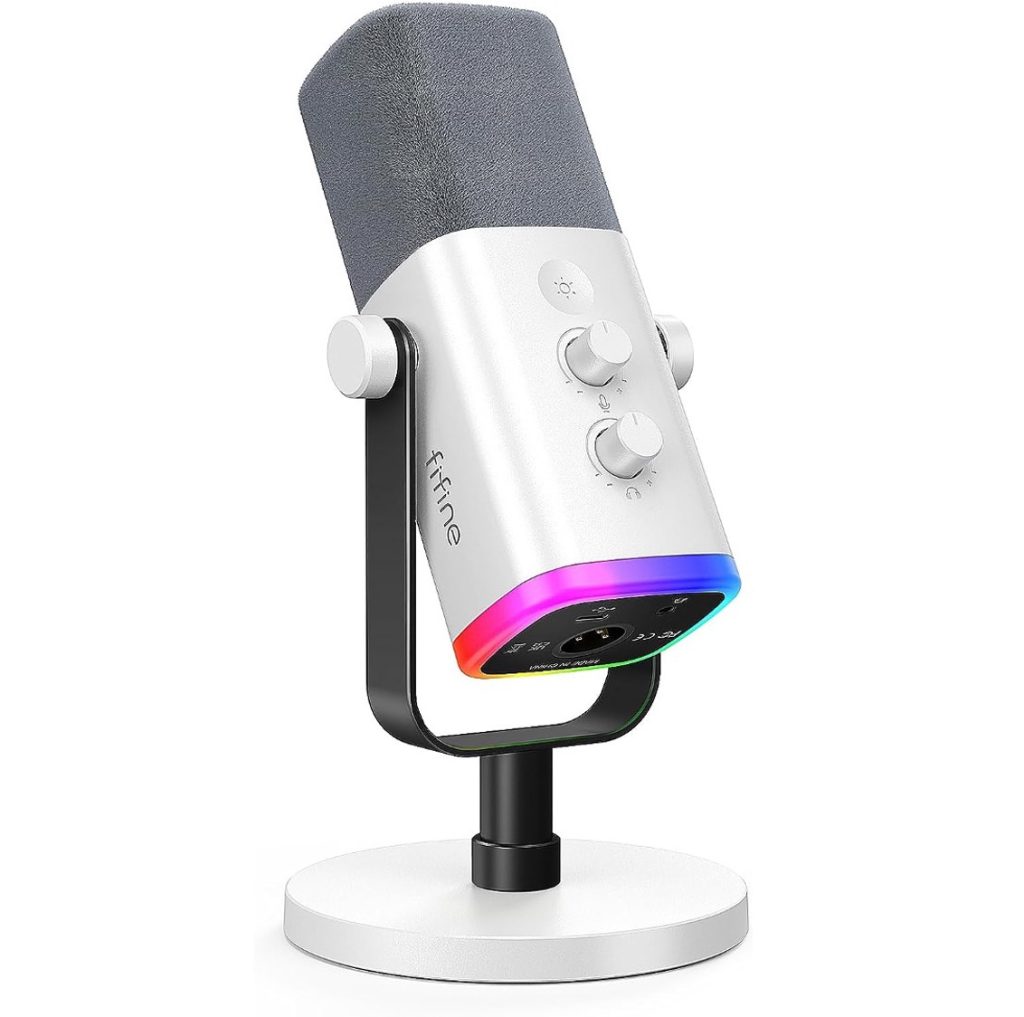
A budget-friendly podcast microphone with dual XLR and USB connections…
The FIFINE K688 USB/XLR Dynamic Microphone is a versatile option for podcasting, streaming, and gaming. It features a frequency response of 50Hz-16KHz and a cardioid dynamic polar pattern which provides natural audio clarity and reduces unwanted ambient sound pickup. This microphone is designed to deliver balanced audio and effectively rejects unwanted off-axis noise, making your voice sound much more engaging with depth.
The microphone’s dual connectivity via XLR and USB-C ports is a key feature, providing flexibility for different recording setups. The USB connection is plug-and-play, eliminating the need for manual driver installation – all you have to do is plug it into the computer to record. This is especially beneficial for beginners or those seeking a hassle-free setup. The XLR connection offers upgrade-ability for more professional setups with audio interfaces and mixers, making it a good choice for home recording studios. However the touch mute button, a useful feature for privacy during live streaming, only functions with the USB connection.
Compared with other podcasting microphones, I really like the FIFINE K688’s dual-mode feature provides the flexibility to start with a simple USB connection and later switch to a more professional XLR setup without needing to purchase a new microphone. While the audio quality is not as good as the Shure SM7B, the Shure SM7B requires an XLR connection and often an additional preamp for optimal performance, which may be more costly for beginners. The FIFINE microphone, with its dual USB and XLR connectivity, offers a more beginner-friendly setup while still providing the option to scale up to more professional setups.
I highly recommend the FIFINE K688 podcasting microphone for beginners due to its really nice sound quality and vocal pickup. Its plug-and-play USB connection is ideal for those new to audio recording, while the XLR option allows for exploration into more advanced recording setups as one’s skills and needs evolve. The cardioid pattern minimizes room noise which makes it easier to record in less controlled environments like home studios. Overall, it’s a really solid budget friendly option that I would recommend for beginner level podcasters.
3. Rode PodMic
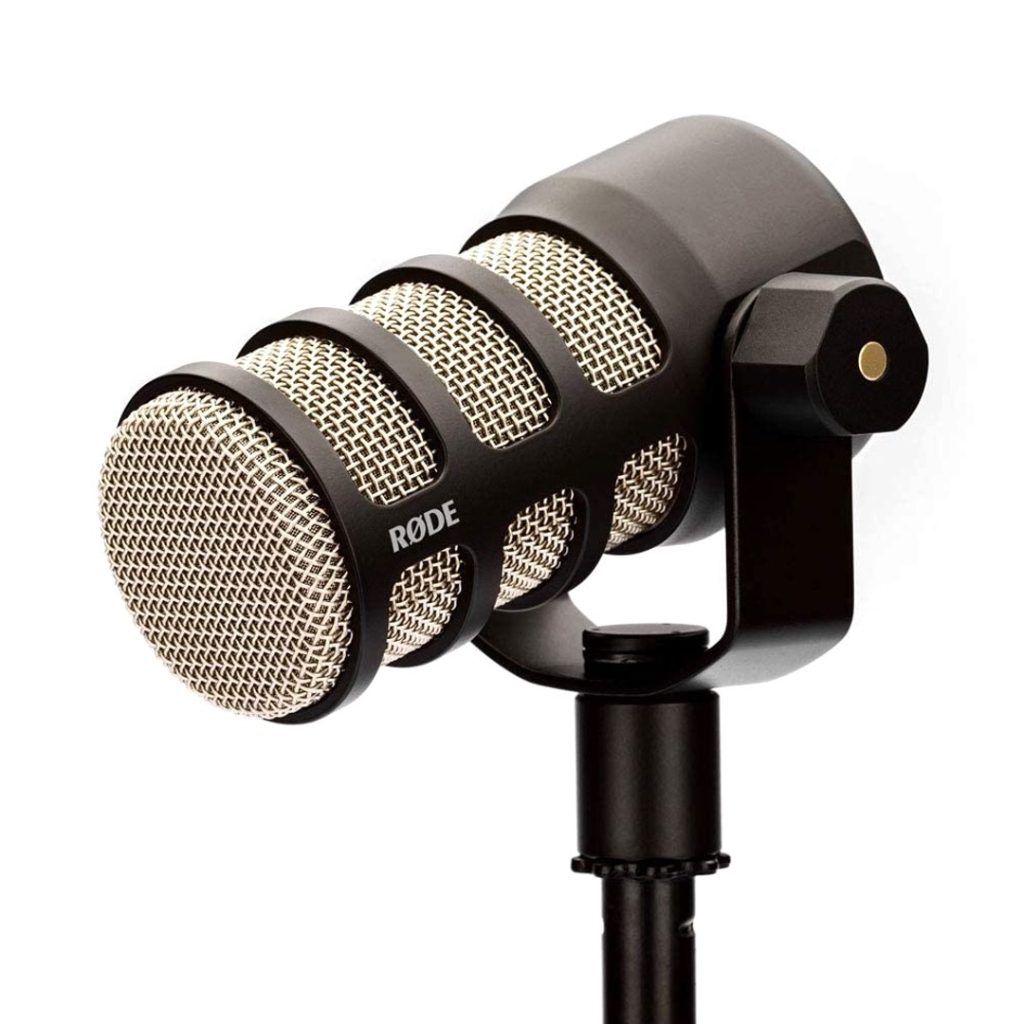
For those looking for better vocal pickup with cleaner details…
The Rode PodMic is a dynamic cardioid broadcast microphone that is adapted specifically for podcasting and provides really clean vocal pickup. It features a frequency response range of 20 – 20,000 Hz, which is quite broad for a dynamic microphone. This range allows for a rich and warm audio capture, making it suitable for a variety of vocal tones. The microphone’s design includes an internal pop filter that minimizes plosives (sounds like ‘p’ and ‘b’), and an internal shock mount that reduces the transfer of vibrations and noise. The PodMic’s robust all-metal construction with a ceramic finish adds to its durability and aesthetic appeal.
The PodMic’s sound quality is often compared to the Shure SM7B microphone, albeit with a bit less warmth and depth. Its sturdy build and integrated features like the pop filter and shock mount make it very easy to beginners to use straight out the box. However, do note that the PodMic has relatively low output, which means it might require a clean gain boost through an audio interface or dedicated preamp for a cleaner output.
Compared to the Shure SM7B, the PodMic is more cost-effective and delivers a similar tonal quality with detailed vocal pickup. This feature makes the PodMic a more budget-friendly choice for those looking for quality audio without the higher cost of professional microphones. While the Blue Yeti Nano and the Rode NT-USB Mini offer higher sampling or bitrates, but may lack the broadcast-quality sound of the Rode PodMic.
Overall, the Rode PodMic is one of the best podcast microphone for beginners that is very easy to use and is essentially plug and play, and comes with an internal pop filter to minimise plosive noises. The Rode PodMic is also optimized for use with the RODECaster pro podcast production studio and offers exceptional sound recordings with any high-quality microphone interface.
4. Shure MV7X XLR Podcast Microphone
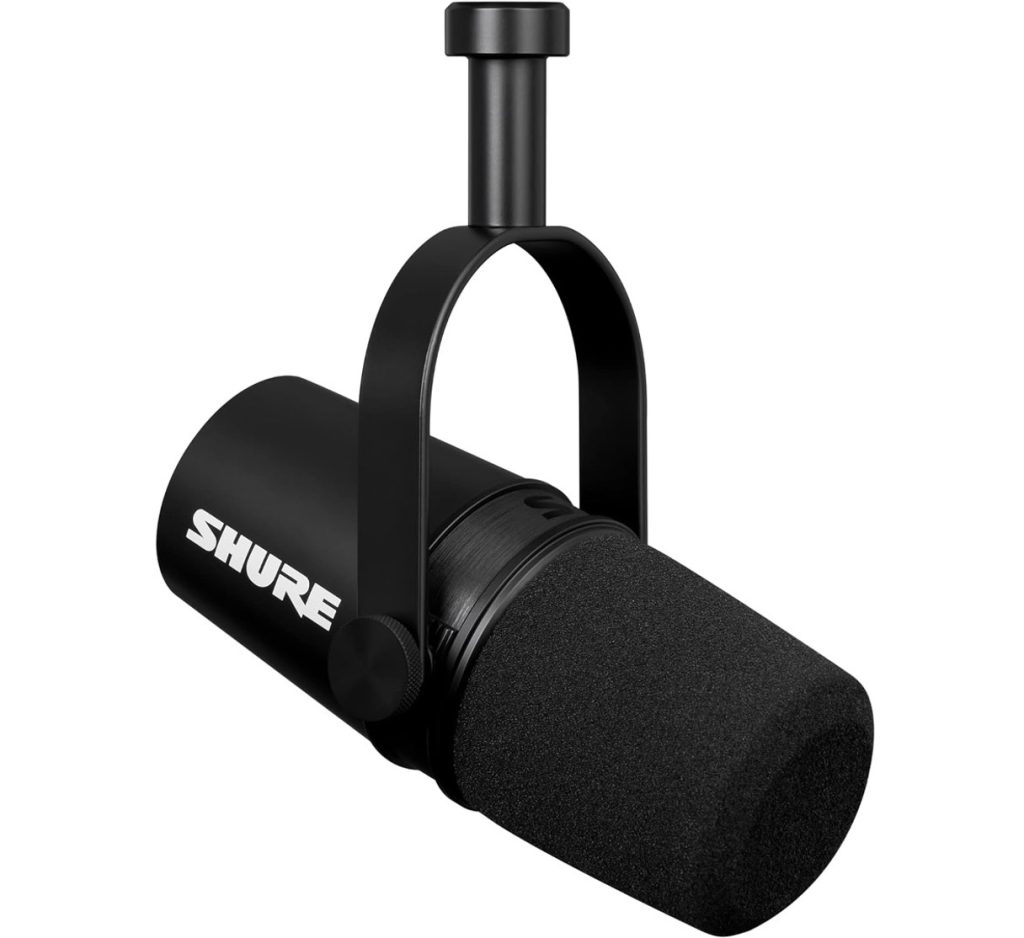
One of the best podcasting microphones from Shure…
The Shure MV7X XLR Podcast Microphone is a dynamic, cardioid microphone designed for podcasting and vocal recording. It shares the same capsule and design as the Shure MV7, with a key distinction being its exclusive XLR connectivity, as opposed to the MV7 which offers both USB and XLR outputs. This microphone weighs 0.55 kg and has a frequency response range of 50Hz-16kHz, sensitivity of -55dBV/Pa, and an output impedance of 252 Ω. The Shure MV7X is modelled after the legendary Shure SM7B for integration into any podcast workstation.
I really like the sound quality of the Shure MV7X microphone – it sounds really warm and engaging, and it can also capture subtle details in your voice which make it great for podcasts. The microphone’s cardioid pickup pattern effectively isolates the voice while controlling sibilance and room reflections. However, a notable con is its susceptibility to plosives, which may require the use of an additional pop filter for close-up speaking.
When compared to other podcasting microphones, the MV7X stands out for its professional audio quality and XLR connectivity, which is adaptable to various recording setups. It competes well with microphones like the Rode PodMic and the Shure SM7B. The MV7X has a somewhat similar sound profile to the SM7B, offering a more budget-friendly alternative without significantly compromising on audio quality. However, unlike USB microphones that are plug-and-play and often feature multi-directional polar patterns, the MV7X’s setup is more suited for traditional recording environments with XLR inputs and audio interfaces. It should be noted that the MV7X lacks the USB port and headphone output present in the MV7 and only works with XLR.
The Shure MV7X is recommended for beginners in podcasting who are looking for a microphone that delivers professional-grade audio quality and have an audio interface or audio workstation. Its XLR connectivity provides compatibility with a wide range of audio interfaces and mixers, making it a versatile choice. Additionally, the dynamic microphone technology of the MV7X excels in capturing clear and detailed vocals, even in less-than-ideal acoustic environments, which is beneficial for home studio setups. While the investment in the MV7X might be on the higher end for some beginners, its top-tier features and performance justify the cost for those who want better podcast audio quality.
5. AUDIOPRO USB Podcasting Microphone
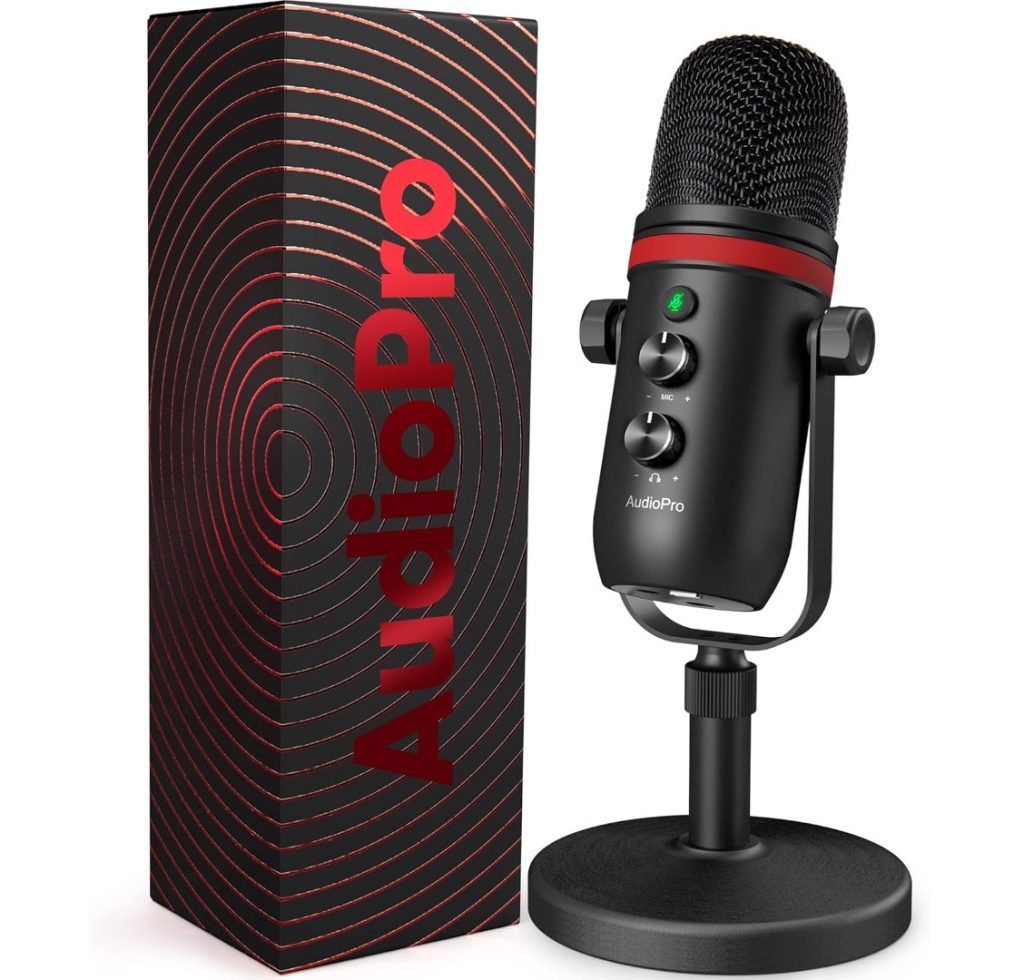
A really compact and easy to use podcasting microphone…
The AUDIOPRO USB Microphone is a compact and versatile mic designed for a range of audio applications including gaming, streaming and podcasting. It features plug-and-play functionality, making it compatible with various devices such as Mac, PS4/5, Windows PC, and even Android phones through USB-A or USB-C ports. This means you won’t need to install any extra drivers to get started and is very intuitive to setup for beginners.
One of its key features is the cardioid pickup pattern which effectively captures clear, smooth, and crisp sound while reducing unwanted background noise. This makes it ideal for podcasting and gaming where clarity of voice is paramount. The microphone supports sample rates up to 192kHz/24bit which provides high-quality audio for a range of applications.
The AUDIOPRO USB Microphone also includes onboard audio controls, allowing you to adjust the mic gain and volume conveniently. Additionally, it features a 3.5mm headphone output for direct, latency-free monitoring and a quick mute functionality that is useful in live scenarios. The built-in LED light indicates the working status of the microphone which adds to its user-friendly design.
I really like the sound quality of the AUDIOPRO USB microphone. This podcast microphone provides really clear and crisp audio pickup and supresses unwanted background noises. You can use the microphone for gaming and streaming on Twitch or for podcasting on YouTube. The microphone is also very simple to install and setup – you can setup the mic essentially by plugging in a USB cable and use the included 5/8” male to 3/8” female adapter to install the mic on a standard boom arm. I like the fact that this microphone comes with an included pop filter which helps you get started right away.
Overall, the AUDIOPRO USB Microphone is highly recommended for beginners in podcasting or those who need a versatile microphone for various audio applications. Its ease of installation, excellent sound quality, and user-friendly features make it a great choice for a wide range of users. It’s overall an exceptional microphone for gaming and streaming and I really like it’s clear sound quality.
6. Blue Yeti USB Microphone
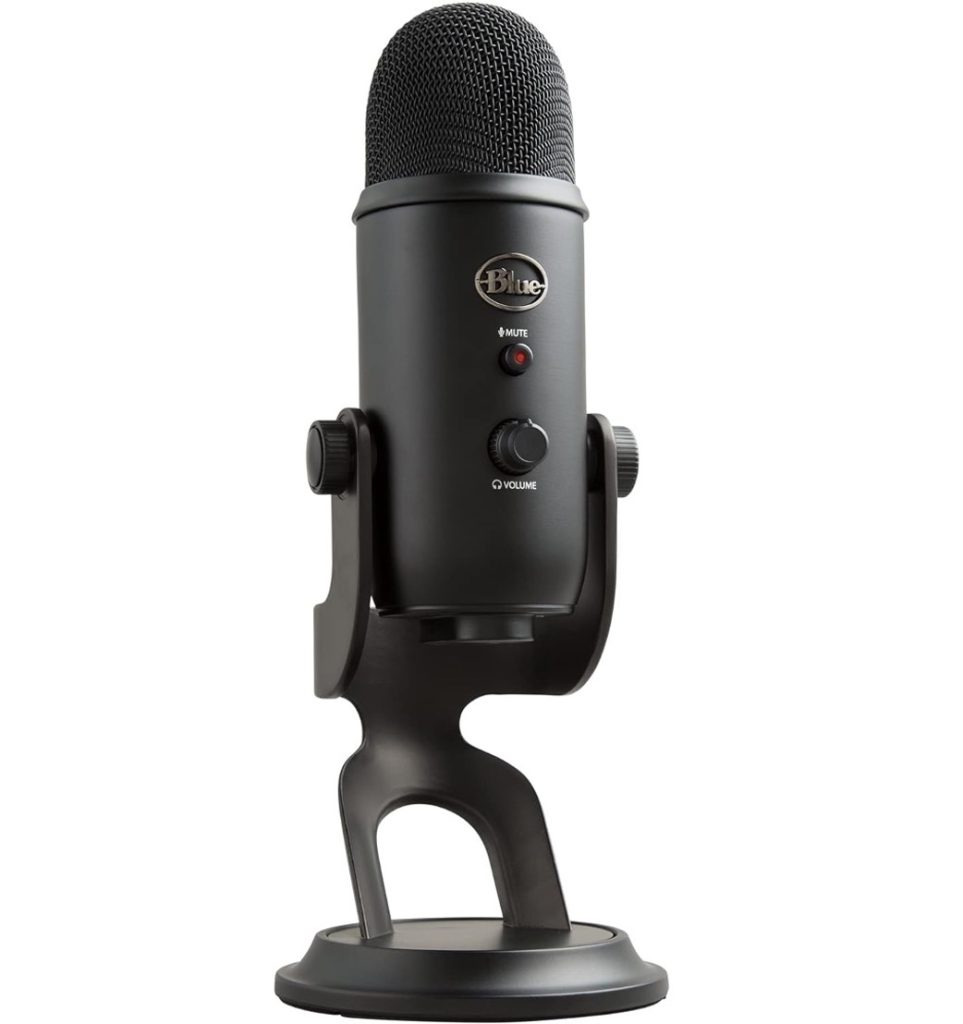
One of the most recognisable brands in the podcasting industry…
The Blue Yeti USB Microphone is a popular choice among podcasters and streamers due to its versatility and ease of use. It features a tri-capsule array, allowing it to offer four different polar patterns: cardioid, bidirectional, omnidirectional, and stereo. This range of patterns enables users to record in various scenarios that would typically require multiple microphones. The Yeti has a frequency response range of 20Hz to 20kHz and captures vocals with crystal clear clarity with an adjustable desktop stand, making it great for tracking your voice in real time with no-latency monitoring.
I really like the Blue Yeti’s plug-and-play functionality which eliminates the need for additional drivers or complex setups. The Blue Yeti mic also comes with onboard audio controls, including headphone volume, pattern selection, instant mute, and mic gain, makes it user-friendly and convenient for adjusting audio levels during recording and streaming sessions. However, its size and weight can be a drawback, as it may require a sturdy stand or boom arm to support it effectively. The Blue Yeti microphone can be quite sensitive to ambient sounds and can pick up unwanted sounds if not used correctly.
Compared to other podcasting microphones, the Blue Yeti comes with a lot of features which make it more convenient to get cleaner audio recordings. For instance, compared to the Samson Q2U, which is a more budget-friendly option and also works as an XLR mic, the Blue Yeti provides more polar pattern options, although the Q2U is often preferred for its XLR connectivity and lower price point. Compared with the Rode Podcaster, I find that the Blue Yeti provides more versatility with its multiple polar patterns and is easier to set up due to its USB functionality (just plug and play).
I highly recommend the Blue Yeti USB microphone for beginner podcasters. It features four pickup patterns which allow you to record in any way that you want and gives you the flexibility of recording in different room environments. The design of the microphone is really sleek and it also features a custom three-capsule array that delivers really nice broadcast-quality sound that captures a lot of detail in your voice. The Blue VOICE software also offers enhanced effects with advanced modulation and HD audio samples, giving you greater flexibility in fine-tuning your vocal recordings.
7. HyperX SoloCast Podcasting Mic
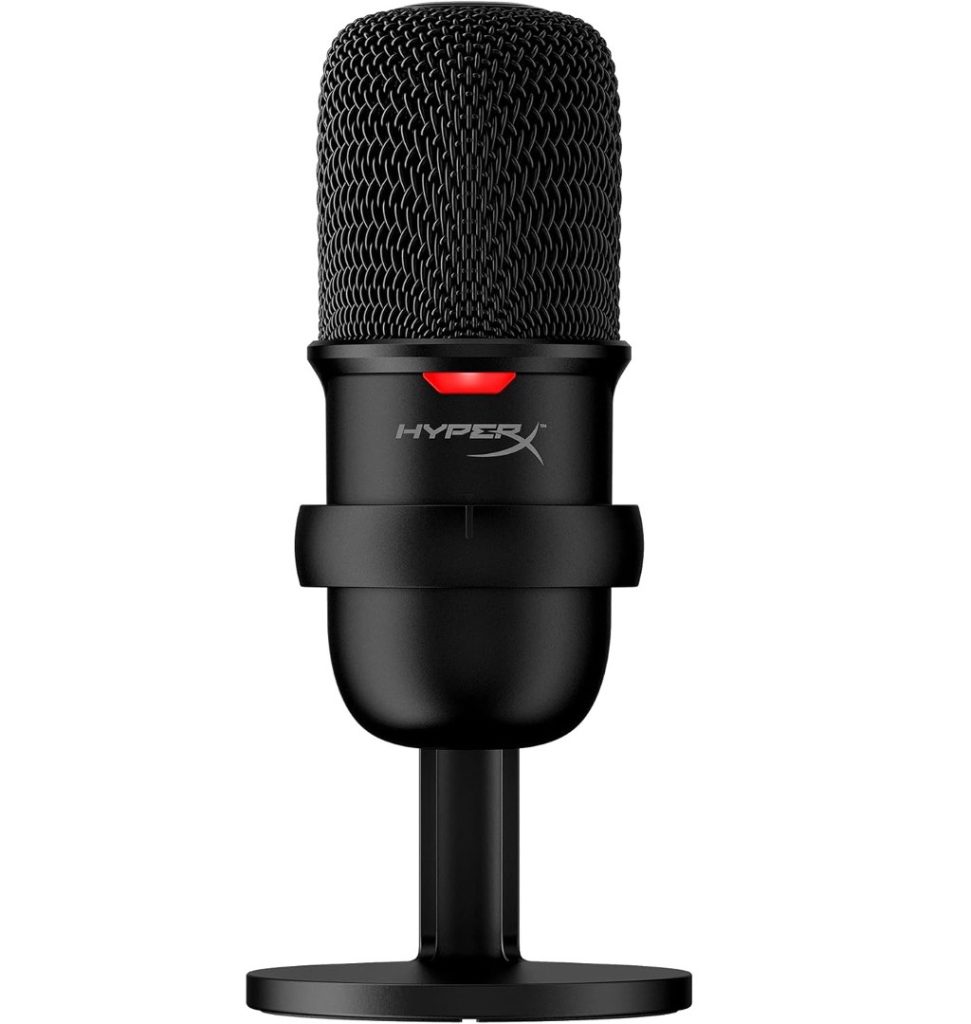
A really easy to use podcasting mic for beginners…
The HyperX SoloCast is a USB condenser microphone designed for simplicity and ease of use and is a really great mic for streaming and podcasting. One of its main features is the Plug N Play audio recording with a USB-C connection, which eliminates the need for additional drivers and simplifies the setup process. The cardioid polar pattern of the SoloCast is adept at capturing sound sources directly in front of the microphone while reducing background noise, making it suitable for focused audio recording in home recording studio settings.
In terms of audio quality, the HyperX SoloCast supports high-resolution 24-bit/96 kHz recording and provides studio-level sound clarity and detail. I really like the sound quality of the HyperX SoloCast – vocals sound clean and very detailed, and the mic adds a layer of warm and engagement to the vocals which makes them sound great for podcasting. Another notable feature is the tap-to-mute sensor with an LED status indicator which a convenient way to control when you want to be heard during live streams.
Compared to the Blue Yeti which offers multiple polar patterns and onboard controls for pattern selection and gain adjustment, the SoloCast focuses on delivering quality sound with a single, effective cardioid pattern and fewer controls. This streamlined approach can be beneficial for beginners who prefer simplicity over versatility in their recording setups; having said that, it does mean that you get less flexibility with the HyperX SoloCast mic.
Overall, the HyperX SoloCast microphone is recommended for beginners in podcasting due to its user-friendly design and quality audio performance. Its plug-and-play functionality makes it accessible for those new to audio recording, while the high-resolution audio support and cardioid polar pattern provide professional-sounding podcasts and streams. The microphone is also compatible with boom arms and mic stands, along with its adjustable stand, which provides flexibility in various recording environments from tight desk setups to more spacious studio arrangements.
8. Elgato Wave 3 USB Microphone
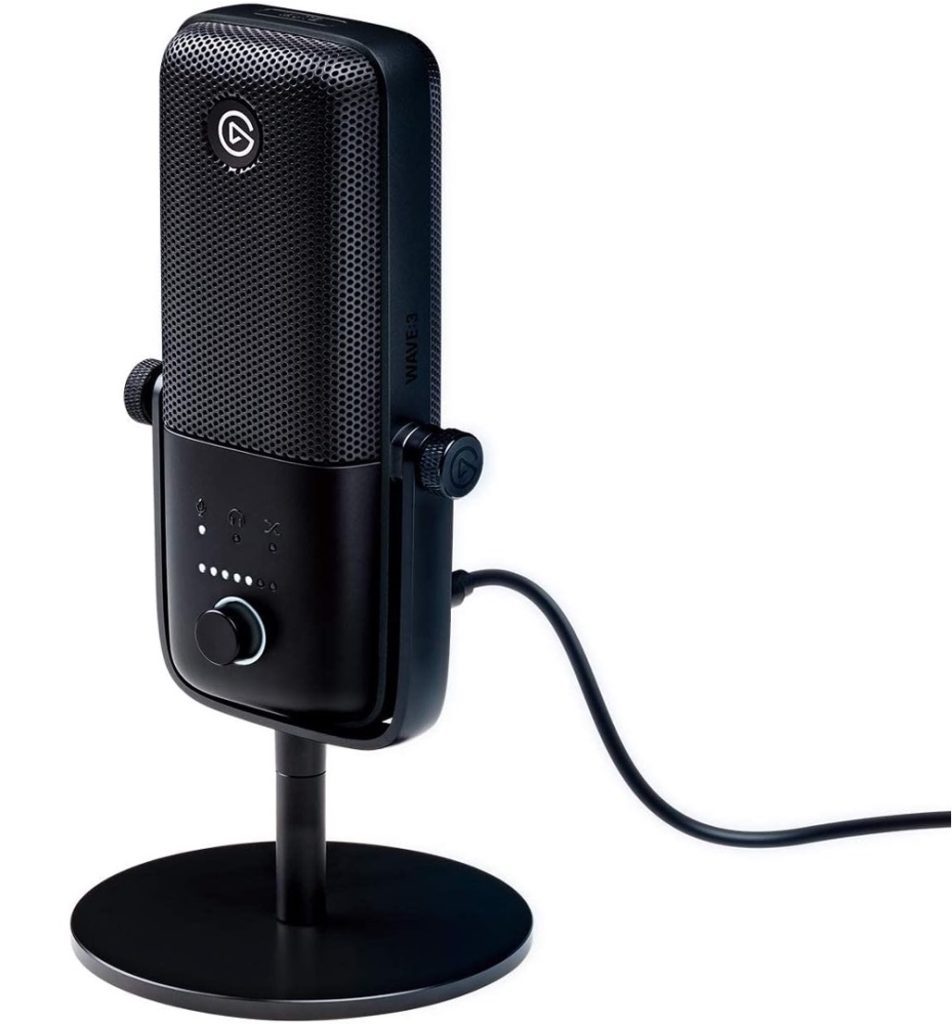
A really good USB podcasting mic for beginners…
The Elgato Wave 3 is a USB condenser microphone designed for podcasting and streaming and is a really good mic for beginners to pick up. It features a cardioid polar pattern which is ideal for capturing clear and detailed speech while minimizing background noise. The Wave 3 stands out with its high-resolution 24-bit/96kHz analog-to-digital converter and provides professional broadcast audio quality. Additionally, Elgato’s proprietary Clipguard technology automatically reducing sudden volume peaks to prevent audio distortion, making it highly ideal for capturing vocals without picking up “boomy” sounds.
I really like the Elgato Wave 3’s sound performance. Vocals sound bright and clean with minimal distortion, and the microphone features superior circuitry which provides a seamless sonic transmission throughout the signal chain. The intuitive Wave Link app also provides control of the microphone and up to eight other audio sources. The app also creates two independent mixes, adding a layer of versatility to audio management. However, the microphone’s focus on a single polar pattern might limit its adaptability in varied recording scenarios compared to multi-pattern microphones.
When compared with other podcasting microphones, the Elgato Wave 3 comes with several unique features such as Clipguard technology and high-resolution recording capabilities for better vocals. Compared with the Blue Yeti which has multiple polar patterns and onboard controls, the Wave 3 focuses more on software integration and audio quality enhancements. The Rode NT-USB, another popular choice, delivers similar sound quality but lacks the advanced software integration and Clipguard technology found in the Wave 3.
I would recommend the Elgato Wave 3 USB microphone for beginners. Its plug-and-play setup, combined with the Wave Link app, makes it easy for newcomers to manage audio settings and mixes effectively. This microphone delivers really clean audio recordings and vocals, and can capture subtle details in your voice with its condenser mic, and the Wave Link app also provides multiple enhancements for audio recordings.
9. Samson Meteor USB Studio Microphone
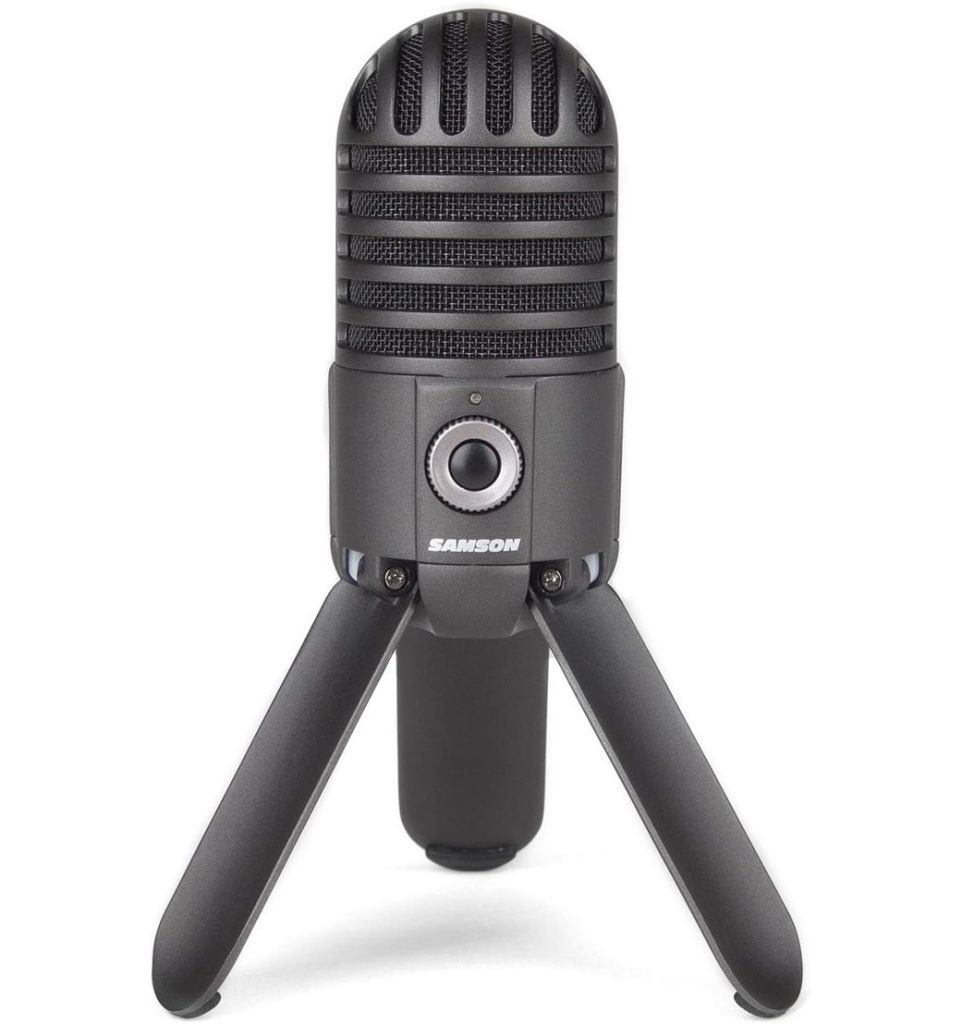
A budget-friendly USB microphone with a large diaphragm condenser…
The Samson Meteor Mic USB Studio Microphone is a versatile USB condenser mic which is adapted for podcasting and live streams. The microphone features a large 25mm diaphragm condenser which delivers rich and detailed audio recordings. The cardioid pickup pattern focuses on capturing sound directly in front of the microphone, making it effective in reducing unwanted background noise. Additionally, the microphone supports a smooth, flat frequency response range from 20Hz to 20kHz and provides CD-quality audio with a 16-bit/44.1/48kHz resolution.
In terms of design, the Samson Meteor Mic features a fold-back leg design which allows for easy positioning and optimal microphone placement. This feature also adds to the microphone’s portability, making it convenient for mobile recording setups or tight workspace configurations. The microphone’s build includes a zero-latency headphone output with level control and a microphone mute switch, granting users complete control during recording sessions.
Compared to other podcast microphones like the Blue Yeti which has more onboard controls and adjustable polar patterns, the Samson Meteor Mic uses a single cardioid pattern and has fewer controls – it is essentially a plug and play microphone. It comes with a large-diaphragm condenser which captures a lot of details in the vocals and provides a smooth podcasting experience.
Overall, the Samson Meteor Mic is one of the best podcast microphones for beginners designed to capture broadcast-quality vocals. The microphone features a fold-back leg design that helps optimize the recording setup and prevent unintended audio disturbances. The Samson Meteor Mic is also a good option for individuals looking for a portable microphone for on-the-go recording and is very easy to setup.
10. MAONO USB/XLR Podcast Microphone
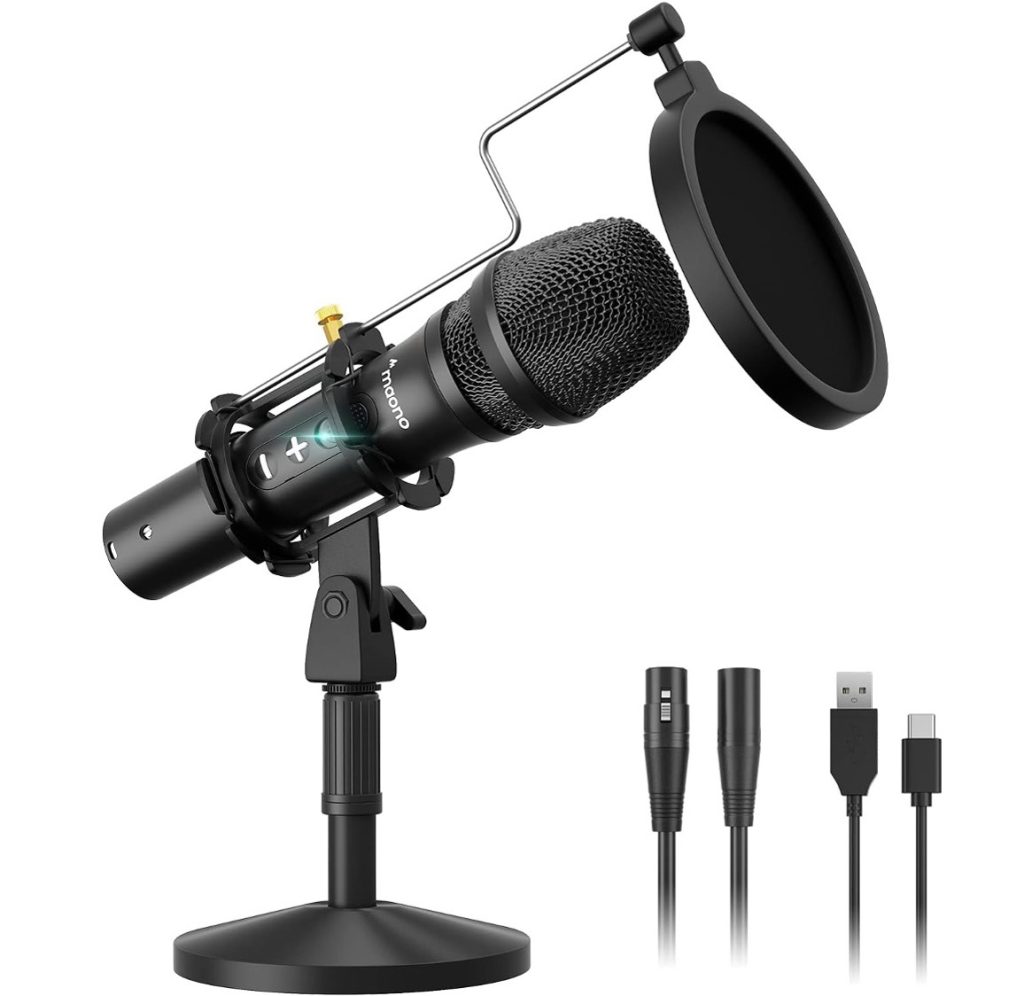
A full podcast microphone studio kit with everything you need…
The MAONO USB/XLR Podcast Microphone is a dynamic microphone that offers a blend of versatility and performance suitable for podcasting, streaming, gaming, and video conferencing. It features dual-mode connectivity, allowing users to connect via USB or XLR, adding flexibility depending on the recording setup. The microphone has a cardioid polar pattern with a built-in cardioid capsule which makes it suitable for recording at home while minimizing ambient audio pickup at the other side or rear.
One of the standout features of the MAONO microphone is its wide frequency response range of 40Hz-16kHz, which provides a rich and natural sound reproduction. This microphone delivers really rich and natural vocal reproduction which makes recordings feel clean and smoother. It also offers a high sample rate and bit depth of 24-bit/48kHz which makes it suitable for professional-level recordings. Additionally, the microphone has adjustable gain and you can control the input level for optimal sound quality while podcasting.
I really like the fact that the MAONO USB/XLR podcast microphone comes as a studio kit with virtually everything that you need including the shock mount and pop filter. Compared to other podcasting microphones such as the Shure SM58, the MAONO microphone provides the added convenience of USB connectivity, which the SM58 lacks. This feature is particularly useful for those who prefer a straightforward, plug-and-play setup without requiring additional audio interfaces. Additionally, the MAONO microphone’s built-in shock mount helps to reduce handling noise and improve recording quality.
Overall, the MAONO USB/XLR Podcast Microphone is a really good podcast microphone to get for beginners and it comes as a studio kit with everything you need to get started. The ability to switch between USB and XLR connections provides versatility and allows you to use the mic directly with your PC or via an audio interface if you have a home recording studio. The MAONO USB/XLR Podcast microphone also features a durable metal construction that provides better durability and long-lasting performance, making it a podcast microphone that you can use for a long time.
Next Steps
If you are setting up your home recording studio for recording and podcasting, be sure to check out our guides on the list of equipment that you need to get started with your home recording studio. If you are getting a podcast microphone that does not come with a pop filter or shock mount, I highly recommend getting those together with your setup to record cleaner vocals.
